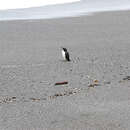en
names in breadcrumbs


Perception Channels: visual ; tactile ; acoustic ; chemical
Although the common murre is not threatened, they are highly susceptible to the damaging effects of oil spills and pollution.
(Terres 1980)
US Federal List: no special status
CITES: no special status
IUCN Red List of Threatened Species: least concern
Unknown.
The excrement of the common murre is rich in potash, which is important for the growth of many marine species. Many of these species are essential food sources for a variety of fish species which have economic uses by humans.
(Terres 1980)
The common murre is mainly piscivorous. They are surface divers that can remain submerged for up to one minute at a time. They often dive to a depth of 100 feet but have been recorded to reach a depth of 550 feet. They use their strong wings to fly underwater. Adults consume between 20g and 32g of food everyday. They mostly catch small fish up to 7 inches in length, which they carry in their bills lengthwise with the tail hanging out. Most of the fish species consumed include polar cod, capelin (Mallotus), launces, sprat (Sprattus), sandeels (Ammodytes), small Atlantic cod and herring (Clupeus). They also eat a variety of marine worms, amphipods, shrimp, molluscs, and Arctic squids.
(Ehrlich 1988, del Hoyo, et al. 1996, Terres 1980)
During breeding, the common murre populations of the Pacific Ocean range from coastal areas of western Alaska to central California. The Atlantic Ocean populations range from Labrador to Nova Scotia. They spend the winters close to the breeding areas but their range extends to southern California in the Pacific populations and to Maine in the Atlantic populations.
(del Hoyo, et al. 1996, Ehrlich 1988)
Biogeographic Regions: atlantic ocean (Native ); pacific ocean (Native )
The common murre is primarily a pelagic species. It spends the majority of its time at sea except for during breeding season. The breeding season is spent on costal cliffs or offshore islands that are primarily rocky. (Ehrlich 1988, del Hoyo, et al. 1996, Terres 1980)
Aquatic Biomes: coastal
Average lifespan
Status: wild: 317 months.
At first glance, the common murre appears penguin-like, as the breeding adults are dark brown-black on the head, neck and back with a white underbelly and white tipped secondary feathers. They are about 38-43cm in length and stand upright like a penguin when on land. They have dark, long, and slender bills and dark greyish-black feet and legs. They have a wingspan of 64-71 cm. The adult winter plumage is mostly identical except for white on the cheeks and throat and a dark spur extending back from the eye. An alternate form, or the bridled morph, only occurs in a population in the North Atlantic. It has an eye ring with a line extending toward the back of its head in addition to the regular adult plumage. Chicks are downy when first hatched. They are blackish brown on top and white underneath. When they are first hatched they weigh 55-95 grams. Juveniles are similar to adults except for their smaller size and darker heads.
(Ehrlich 1988, del Hoyo, et al. 1996, Terres 1980)
Range mass: 945 to 1044 g.
Other Physical Features: endothermic ; bilateral symmetry
Average basal metabolic rate: 6.8224 W.
The first breeding season takes place at the age of 4-6 years. The common murre does not use nesting material, as the one egg is laid on the bare rock or soil of a steep cliff or ledge facing the sea. The egg is pyriform or pear-shaped which prevents it from rolling off of the ledge. This is because the egg pivots around the pointed tip when it is disturbed. The shape also maximizes the amount of surface area that will be in contact with the parent's brood patch during incubation. Eggs are laid between May and July in populations breeding on the Atlantic coast and between March and July on the Pacific coast. The eggs vary in colour from pure white to shades of green, blue, or brown with spots or speckles of brown, lilac, or black. These various colour forms are important for egg recognition by parents. Both parents participate in the incubation process, which takes between 28 and 34 days and is divided into 12-24 hour shifts. Chicks of the common murre are semiprecocial. Chicks fledge (leave the nest) at 18-25 days and go out to sea with the male of the pair. The chick is able to fly at the age of 39-46 days. (Ehrlich 1988, del Hoyo, et al. 1996, Terres 1980)
Key Reproductive Features: iteroparous ; gonochoric/gonochoristic/dioecious (sexes separate); sexual ; oviparous
Average time to hatching: 31 days.
Average eggs per season: 1.